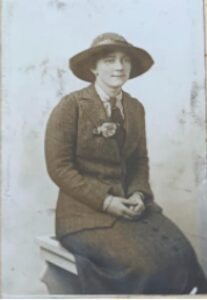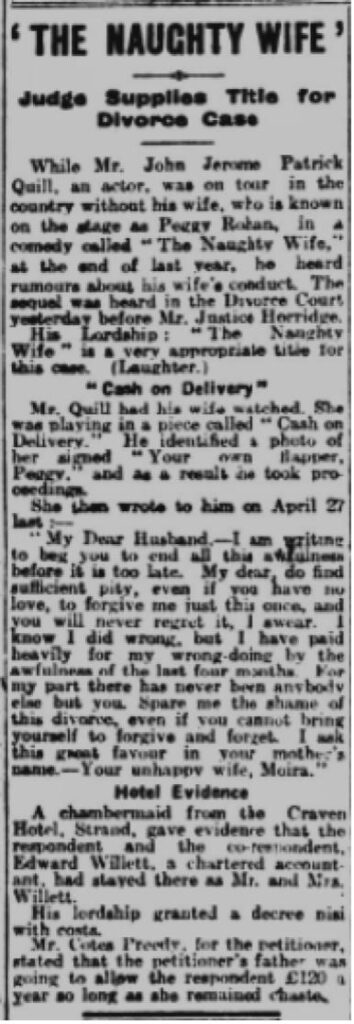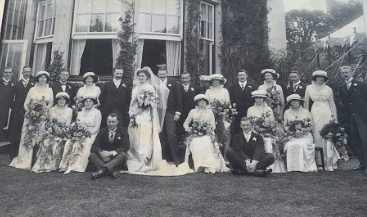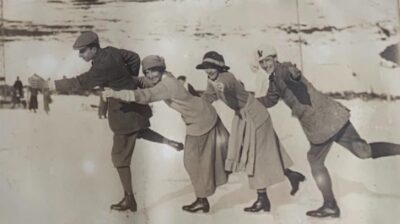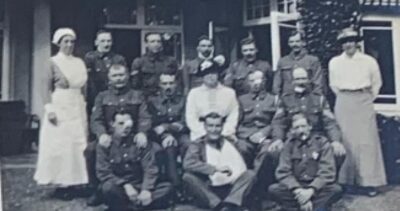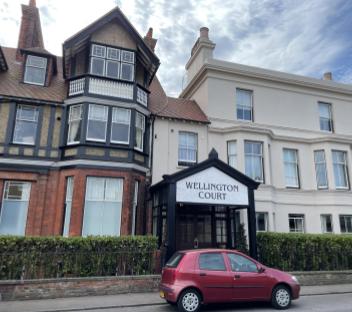Follow us on Facebook @FHofDW
Evelyn Maud Fearon Quill
East Stonehouse Barracks, Plymouth.Devon
Bury Road, Gosport, Hants
Harefield House, 20, Beach Rd, Walmer, Kent
Fair Maid Of Kent Hotel, Dover Road,Walmer, Kent
The Manor House, Upper Deal Kent
Amongst the archive in Deal Museum we discovered a large, well-worn scrap book. On closer inspection it revealed a marvellous collection of programmes, photographs and newspaper reviews, circa 1913-1923, of productions staged at The Globe Theatre, which was situated in the Royal Marines Depot, Walmer. One name is mentioned in all of these productions, Evelyn Quill. Turning the book around and starting from the other end it is clear to see that this, now old and fragile, album has been used to display personal, family photographs including a report from ‘The Sportsman’ which shows a full length photograph of a young lady with a croquet mallet labelled as Evelyn Quill. This young lady appears in many of the other photographs too, so we feel we can say, with a great deal of certainty, that this intimate record of a family and Walme was made by Evelyn.
Research showed that from around 1901 Evelyn Maud, Fearon Quill lived with her parents, Honorary Lieutenant Colonel John Jerome Quill and his wife Maud, and two older brothers at Harefield House, The Beach, Walmer.
Her father, John Jerome Quill, was born in Tralee, County Kerry, Ireland in Dec 1849. He enlisted in the Royal Marines Light Infantry at HQ Chatham in 1868 at the age of 18 years. He was then sent to the Walmer Depot as a naval cadet where he undertook four years of training. During his first year he took his ‘Examination for Marine Commissions’ at the Royal Naval College, Portsmouth. He passed, coming 11th in a class of 30 and was then eligible for the commission of Lieutenant.
Lieutenant Quill went on to have a distinguished career, wounded in action several times, and being ‘mentioned in despatches’ twice whilst serving on the West Coast of Africa in 1873 during the Anglo – Ashanti Wars. Here he spent some of his time at Cape Coast Castle, notorious as the prison where, until abolition, thousands of slaves were once kept before their transportation to the West Indies.
By the end of this year John is returned to Chatham after suffering from a long bout of ‘bad fever’. On his recovery he joined the crew on HMS Raleigh, one of the Mediterranean fleet until he was returned to Chatham, once again, to be promoted to Adjutant, ( military officer who acts as an administrative assistant to a senior officer ). It is possible his health was not up to the rigours of going to sea.
It is in his role as Adjutant that in 1880 he was posted to Stonehouse Barracks, Plymouth where he meet his future wife, the 17 years old Maud Agnetta Simpson, daughter of Lt. Col. Surgeon RMLI, George Simpson deceased; step-daughter of Lt. Col. John Sanders. Two years later, at the age of 33 years, John, now promoted to Captain adjutant, married his teenage bride at Stoke Damerel Church and their three children follow in quick succession, all being born and baptised at the same church in East Stonehouse, Plymouth.
John’s career in the Marines continued to progress. By 1895 he and the family were living in Alverstoke, Gosport, where, having been promoted to Leiutenant Colonel of his regiment at the Portsmouth Division, he was present at a Military parade on Southsea Common. A commotion occurred and he was thrown from his frightened horse receiving severe injuries to both his head and shoulder.
Having eventually recovered from his injuries he was appointed as Barrack Master at the Depot in Walmer. In the absence of a 1901 census for the Walmer area we are not sure when he and his family settled into ‘Harefield’ on The Beach but they were certainly there by 1911. John retired, due to age, in 1903. Maud died in Walmer on March 2 1917 and John passed away in 1926. Both are buried in the old St Mary’s churchyard.
Evelyn’s eldest brother, John Jerome Jnr. was born in 1883. Like Evelyn, he was outgoing and ambitious. 1901 finds John as a pupil of the prestigious Wellington College in Berkshire. John, like his sister, displayed thespian tendencies and both before and after the war he took to ‘the boards’ in a professional capacity. It is a little difficult to follow his career as it seems he changed his stage name several times being listed as ‘John Jerome Quill’ ‘John Jerome Patrick Quill’, ‘Jerome Quill’ but mostly as ‘Patrick Quill’. Where the name, ‘Patrick’ originates, or when he first started using it we’re not sure but it is not included on his baptism record. So we think we can safely say that ‘Patrick Quill’ was his stage name.
In 1906 he was performing at the Public Hall, Woking as the King of Morocco in the Merchant of Venice. 1907 he acted with Sir Henry Irving’s son in Louis X1, at The Royal Theatre, Manchester. During that year he was nominated to become a member of the Actor’s Association ( Equity ).John now seems to have had a change of heart, or maybe his parents encouraged him to take up a ‘proper career’ after all that expensive education and he succeeds in gaining a place at Clare College, Cambridge where he becomes a member of the ADC (Amateur Dramatic Club) Theatre, the oldest University theatre in the country. By October 1909 he gained a BA and was petitioning to be accepted as a Student of Law in Ireland. Whether he was accepted or not is not recorded, but between 1912 and 1917 John, now mostly known as Patrick, was, once again, to be found travelling all around the country performing a variety of roles. He became a member of the prestigious Frank Benson Shakespeare Company which produced an annual play at Stratford in the Memorial Theatre and was well known for its touring productions. John (Patrick) would have been paid a modest salary but what training he would have received alongside other young actors such as Isadora Duncan! Sir Charles Hawtrey engaged him as part of his cast of General John Regan in 1913 at The Apollo Theatre, London, and ‘ The Marriage…..Will Not Take Place’ by Alfred Sutro. This Hawtrey is no relation to the ‘Carry On’ Charles Hawtrey.
Despite his obvious enjoyment at being on stage he enlisted with the Motor Machine Gun Corps at the start of WW1.This unit of the British Army consisted of batteries of motorcycle/sidecar combinations carrying Vickers machine guns. Although,at the beginning of the war this was a useful weapon against the German armies it was soon discovered motorbikes were not practical as the conflict turned to trench warfare.Consequently most batteries were disbanded on the Western Front during the course of 1916 although they eventually came in to their own as the war drew to a close.There is no doubt the men who signed up for this regiment were either extremely brave or reckless adventurers. To ride into enemy fire with a machine gun on your handlebars or positioned in your sidecar must have taken an enormous amount of courage.
In May 1916 John married (Stage name Peggy Rehan, real name Moira Guthrie ) a musical, comedy actress.In 1917 he’s Stage Manager at The Garrick for Hawtrey’s theatrical company.
At the end of 1919 John discovered his wife was having an affair with an accountant! To make matters worse he was performing on stage in the play ‘The Naughty Wife’, a fact which caused much hilarity in the Divorce Court! In April 1920 she wrote him a letter begging for forgiveness but John continued with the divorce, producing the letter in court. the contents, of which, were soon splashed across the newspapers. His father promised to pay Moira £120 annually if she did not marry again and remained chaste.
After the divorce John became a member of The Liverpool Repertory Theatre around 1923 and in 1924 the newspapers reviewed his performance at the Devonshire Park Theatre, Eastbourne, as part of the cast of ‘The Three Wives’ and it seems he was also acting as production stage manager under the name of Patrick Quill.
In 1929 he appeared in the newspapers when he contributed to the case of a ‘cancelled contract’ of an actor. Whilst giving his testimony Patrick states that he had spent some of his career in the position of manager for Sir Charles Hawtrey (The Stage – 24 Jan 1929 ).
Patrick was still performing in 1928 and remarried in 1946. He died on 29 August 1972 in Ewell, Surrey.
Evelyn’s other brother, Berkeley Campbell Quill was born in Plymouth in 1884. Unlike his brother he followed his father into the services.. During WW1 he joined the Queen’s Royal Regiment West Surrey as a Lieutenant and served throughout the conflict. Promoted to Captain in 1918 he was awarded the Military Cross when he was attached to the Scottish Horse Yeomanry.He married a divorcee, Muriel Grace Lambert who came with her son from her first marriage.
In 1936 he and Muriel were living in Witley, and Berkeley was a Major in the Reserve Of Officers. By 1947 he and Murial were to be found living in Aberdeen.Their son fought in WW2 and was a Japanese prisoner of war having been captured in Singapore but returned home safely.
Evelyn was the last child of the marriage of John and Maud. She, like her brothers, was born at Stonehouse Barracks in Plymouth, Devon on 15th June 1887.We were not able to discover where Evelyn was educated but we do know from the album that she was a fun-loving girl who greatly enjoyed playing tennis and excelled at Croquet competing in several National Ladies Championships.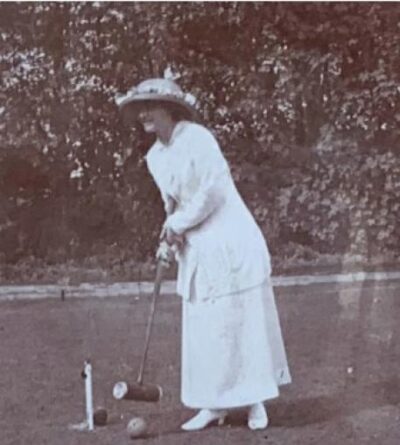
The scrapbook shows us that she had many friends including Gladys Congdon, daughter of Col and Mrs Congdon of Beachlands. When Gladys married Thomas Elphinston in June 1913 Evelyn was one of ten bridesmaids.
The Scrap Book also contains proof of her involvement in Amateur Dramatics. It seems Evelyn, like her oldest brother,had a talent for acting and was a leading light of the Royal Marines Globe Theatre in the early 20th century.These were obviously extremely popular events. A review in the publication ‘The Gentlewoman’ 1907 informs us throughout a run of Pinero’s The Magistrate the theatre was , ‘Crowded each night when most of the leading families of Walmer and the Neighbourhood were present.’ In that particular production ‘Miss Evelyn Quill undertook her small part with great appreciation.’ She meticulously cut out and pasted in all her reviews from the local paper.Included in the album are the programmes, cast lists and a few photographs of the players in action.
In 1908 Evelyn was taken by her mother to Buckingham Palace and presented to the King and Queen, her official ‘coming out’. She seems to have enjoyed travelling. Her scrapbook shows her spending a winter holiday, with friends, in St Moritz.
She continued to travel around the British Isles playing Croquet, often partnered by her father, and indulging in a cruise to the West Indies. During the first world war Evelyn joined her mother supporting the Red Cross including at the Canadian War Hospital in Walmer.
After the death of her father Evelyn married a local, wealthy, Land Agent John Wilks of Manor House, Upper Deal. T the time she was residing at The Fair Maid of Kent on Dover Road which is now Wellington Court. Her brother, John is a witness at the wedding which took place in Mayfair and possibly gave her away.
Evelyn was not to enjoy many years of married life as she sadly died in 1933 at the age of 46. She and her husband had sailed across to Calais in their yacht where, during the visit, Evelyn tripped over a tram line cutting her knee. They returned the next day to Deal where she received treatment for the wound but by Saturday she was admitted to Deal Memorial Hospital with breathing problems and tragically died of sepsis.
Evelyn is buried in St Martin’s Churchyard,Great Mongeham, where her husband was laid to rest with her after his death in 1938.
A short life; but we have been left with a lasting images of life in Walmer stretching from the halcyon days enjoyed by the daughter of a Colonel with her plentiful friends, holidays, weddings, picnics and amateur dramatics through to the dark days of WW1 in Walmer and Deal and on to the ‘Roaring Twenties’! People, places, fashion and cars are all preserved in the wonderful time-capsule that is Evelyn Quill’s scrapbook. We can’t wait for it to be restored and available for visitors to enjoy at Deal Museum.
Sources and further reading:
Deal Museum PA-EQ/1
Newspaper image © The British Library Board. All rights reserved.
With thanks to The British Newspaper Archive (www.britishnewspaperarchive.co.uk)
